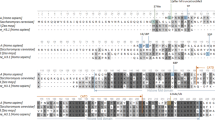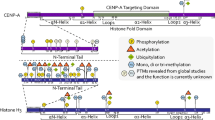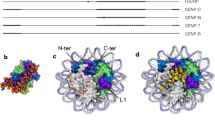Abstract
The centromere is a specialized chromatin region that functions as foundation for kinetochore formation in mitosis. As a result, it is essential for proper chromosome segregation and the maintenance of genomic integrity. The centromere is defined epigeneti cally by the presence of the histone H3 variant CenH3 that is exclusively found within centromeric chromatin. Additionally, centromeric chromatin displays unique posttranslational modifications that differ from the surrounding heterochromatin.
Similar content being viewed by others
Literatur
Blower MD, Karpen GH (2001) The role of Drosophila CID in kinetochore formation, cell-cycle progression and heterochromatin interactions. Nat Cell Biol 3:730–739
Regnier V, Vagnarelli P, Fukagawa T et al. (2005) CENP-A is required for accurate chromosome segregation and sustained kinetochore association of BubR1. Mol Cell Biol 25:3967–3981
Earnshaw WC, Rothfield N (1985) Identification of a family of human centromere proteins using autoimmune sera from patients with scleroderma. Chromosoma 91:313–321
Black BE, Jansen LE, Maddox PS et al. (2007) Centromere identity maintained by nucleosomes assembled with histone H3 containing the CENP-A targeting domain. Mol Cell 25:309–322
Dunleavy EM, Roche D, Tagami H et al. (2009) HJURP is a cell-cycle-dependent maintenance and deposition factor of CENP-A at centromeres. Cell 137:485–497
Foltz DR, Jansen LE, Bailey AO et al. (2009) Centromere-specific assembly of CENP-a nucleosomes is mediated by HJURP. Cell 137:472–484
Jansen LE, Black BE, Foltz DR et al. (2007) Propagation of centromeric chromatin requires exit from mitosis. J Cell Biol 176:795–805
Mellone BG, Grive KJ, Shteyn V et al. (2011) Assembly of Drosophila centromeric chromatin proteins during mitosis. PLoS Genet 7:e1002068
Schuh M, Lehner CF, Heidmann S (2007) Incorporation of Drosophila CID/CENP-A and CENP-C into centromeres during early embryonic anaphase. Curr Biol 17:237–243
Pauleau AL, Erhardt S (2011) Centromere regulation: new players, new rules, new questions. Eur J Cell Biol 90:805–810
Moreno-Moreno O, Torras-Llort M, Azorin F (2006) Proteolysis restricts localization of CID, the centromere-specific histone H3 variant of Drosophila, to centromeres. Nucleic Acids Res 34:6247–6255
Heun P, Erhardt S, Blower MD et al. (2006) Mislocalization of the Drosophila centromere-specific histone CID promotes formation of functional ectopic kinetochores. Dev Cell 10:303–315
Author information
Authors and Affiliations
Corresponding author
Additional information
Debora Bade Jahrgang 1986. 2005–2010 Biologiestudium an der Universität Heidelberg. Seit 2010 Promotion an der Hartmut Hoffmann-Berling International Graduate School of Molecular and Cellular Biology, Universität Heidelberg.
Sylvia Erhardt Biologiestudium an der Universität Heidelberg. 2003 Promotion an der Universität von Cambridge, UK, danach Postdoc an der Universität von Berkeley, CA, USA. Seit 2008 Nachwuchsgruppenleiterin des Exzellenzclusters CellNetworks im ZMBH an der Universität Heidelberg.
Rights and permissions
About this article
Cite this article
Bade, D., Erhardt, S. Die Histonvariante CenH3 reguliert die Centromeridentität. Biospektrum 18, 387–389 (2012). https://doi.org/10.1007/s12268-012-0198-4
Published:
Issue Date:
DOI: https://doi.org/10.1007/s12268-012-0198-4




